ADVANCED MICROECONOMICS TOPIC 6 THE THEORY OF THE FIRM
ADVANCED NE2000 COMPATIBLE CARD DRIVER INFORMATIONPROFESSIONAL EXCELLENCE ADVANCED SKILLS TRAINING FOR
ADVANCED TOOLING SYSTEMS UK LTD PLANT LIST
053B ADVANCED CONVERSATION QUIZ 1 MARCH 17 2006 NAME
11 Supplementary Record Form Advanced Livestock Record Rabbits 20to
111 DERIVING DYNAMIC PROGRAMMING ADVANCED MATH THIS LECTURE REALLY
EC9101 - Seminar in Microeconomics
Advanced Microeconomics
Topic 6: The Theory of the Firm
Primary Readings: DL – Chapter 3
(Not concerned with the emergence of the firm and why firms exist, but with the behaviour of a profit-maximizing firm. On the former, see X. Yang & Y-K Ng, Specialization and Economic Organization, 1993, Ch.9 and references therein.)
In this lecture, we will analyze the behavioral side of the firm, namely, what would a firm behave. We start with the profit maximization, then discuss the profit function, and end up with the duality issues.
6.1 Profit Maximization
A basic assumption of most economic analysis of the firm behavior is that a firm acts so as to maximize its profits, the difference of the revenue and the cost. This leads to the fundamental condition (Production Law):
Choose the level of output such that marginal revenue = marginal cost.
A firm must also face the decisions on how much of a specific input to use/hire.
The second fundamental condition of profit maximization is the condition of equal long-run profits.
6.1.1 The Profit Function
Let us return to the general framework where a firm is described by a production possibility set Y Rm. Let y Y be a netput vector and p the associated price vector. Here, p contains component prices for all netputs, inputs, outputs, and quantities that can be either input or output.
Profit Function. Let Y be a production possibility set. Then the corresponding profit function is
![]()
A graphical illustration of the profit function is as follows.
y2
(p)=p.y
Isoprofit p Y
y1











If the firm has a single output, the profit function becomes:
(p, w) = max pf(z) – w.z
where q = f(z) is the production function of the firm. Then the first-order conditions for this special case are (interior solutions only):
![]()
That is, the value of the marginal product of each factor must be equal to the factor's price. (Do you see that this is a special case of MR = MC?)
The diagram below illustrates the above FOC for single input case.
output
q
= /p
+ (w/p)
z slope
= w/p q
= f(z) /p
input






The second order condition is as usual: the Hessian matrix of f is negative semidefinite at the optimal point.
Properties of Profit Functions: The above defined profit function (p) is
non-decreasing in output prices, non-increasing in input prices;
homogeneous of degree 1 in p;
convex in p;
continuous in p.
Properties of the profit function have several uses. In particular, these properties offer some observable implications of profit-maximizing behavior:
Whenever some property is not true, we can claim that the firm is not a profit-maximizer.
Example
(Cobb-Douglas Production, decreasing returns to scale)
![]()
Let w1 and w2 be the prices of the two inputs and p the price of the output. Then
![]()
which leads to
![]()
(A derivation is placed in the Technical Appendix at the end of the note.)
Note:
Assume that the production technology shows the constant returns to scale, then the profit function is degenerate, namely, taking a value of either 0 or infinite.
What will be the profit function for CES technologies? For example, Leontief production function?
6.1.2 Net Supply Functions and Hotelling's Lemma
Net Supply Functions - Input Demand & Output Supply Functions
The solution of the profit maximization problem:
![]()
is denoted by y = y(p), which is commonly called net supply function of the firm. Clearly,
(p) = py(p).
In particular,
if yi is an input, then the corresponding function yi(p) is called the input demand function, also known as factor demand function.
similarly, if yi is an output, then the corresponding function yi(p) is called the output supply function, or simply supply function.
Hotelling's Lemma
If you know the profit function, then according to the following well-known lemma, Hotelling's Lemma, it is easy to find the net supply function: just differentiate the profit function.
Hotelling's Lemma. Let yi(p) be the firm's net supply function for good i (i = 1,…, m). Then,
![]()
assuming that the derivative exists and that pi > 0.
Proof: Suppose y* is a profit maximizing netput vector at prices p*. Then define the function:
g(p) = (p) - py*.
Clearly, the profit-maximizing production plan at prices p will always be at least as profitable as the production plan y*. But, the plan y* will be a profit-maximizing plan at prices p*, so the function g obtains a minimum value of 0 at p*, which is an interior solution according to the (positivity) assumptions on the prices. We can then use the first-order condition on g:
![]()
Since this is true for all choices of p*, the proof is completed.
Note:
Of course, we can directly apply the Envelope Theorem.
Try to gain some intuition by looking into the simple case:
(p, w) = maxz (p f(z) - w z)
A geometrical intuition is as follows:
Profits
(p)
(p)
= p y*
- w
z*
(p*)
p*
Output Prices (p)






6.2 Comparative Statics Analysis
Economists refer to the analysis of how an economic variable responds to changes in its environment as comparative statics.
The term “comparative” refers to comparing a “before” and a “after” solution.
The term “statics” refers to the idea that the comparison is made after all adjustments have been “worked out;” that is, we must compare one equilibrium situation to another.
In optimization, it is known as sensitivity analysis.
6.2.1 Comparative Statics of Input Demand Functions
Case 1: Single input: maxz p f(z) - w z
Assume that f is differentiable. Let z = z(p, w) be the input demand function. Then the first-order and the second-order conditions are:

As the FOC holds for all p, we differentiate it w.r.t. w and get
![]()
Key implication of this result:
Input demand curve slopes downward in its own price
Similarly, we can also differentiate the FOC w.r.t. p:
![]()
Key implications:
Input demand curve shifts upward when output price increases
(Subject to no-shutting down), a one percentage increase/decrease in output price has the same (positive/negative) effect on output as a one percentage decrease/increase in input price
Now, if look at the issue from the profit function:
(p, w) = p f(z(p, w)) - wz(p, w),
then

This just verifies the Hotelling's lemma.
Case 2: Two inputs: max pf(z1, z2) - (w1 z1 + w2 z2)
Denote the input demand functions as z1(w1, w2) and z2(w1, w2) (we deliberately drop off the output price argument for ease of discussion.) The FOCs are as follow:
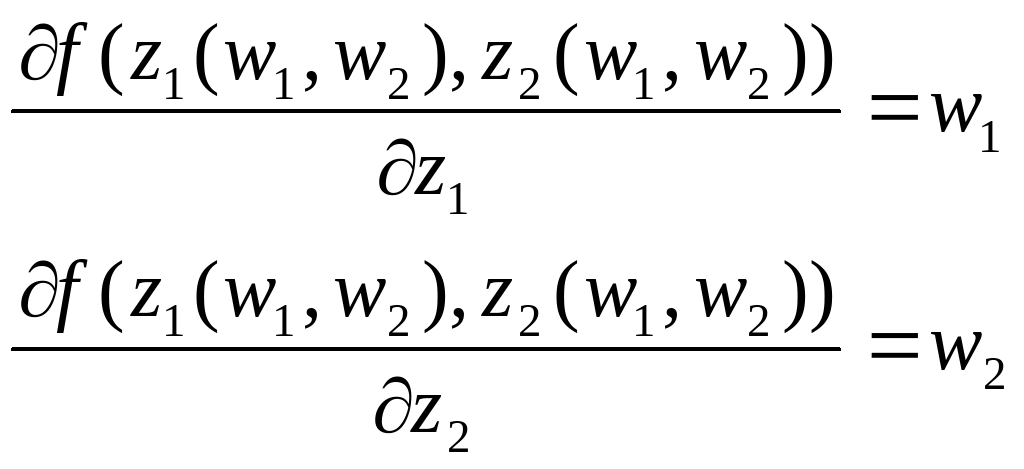
Differentiating w.r.t. w1, we have
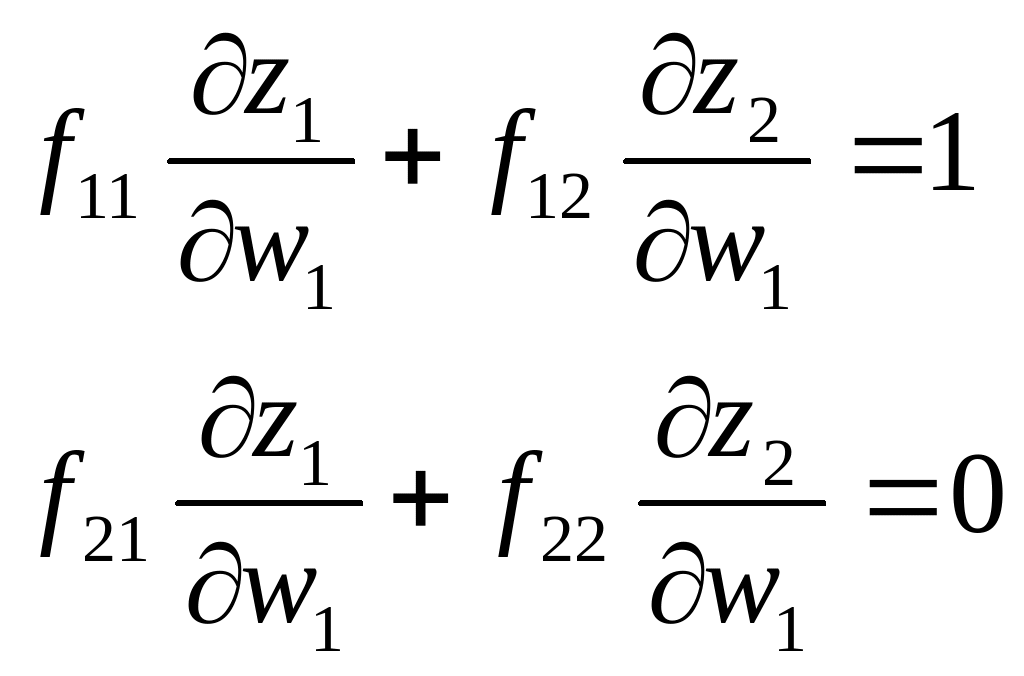
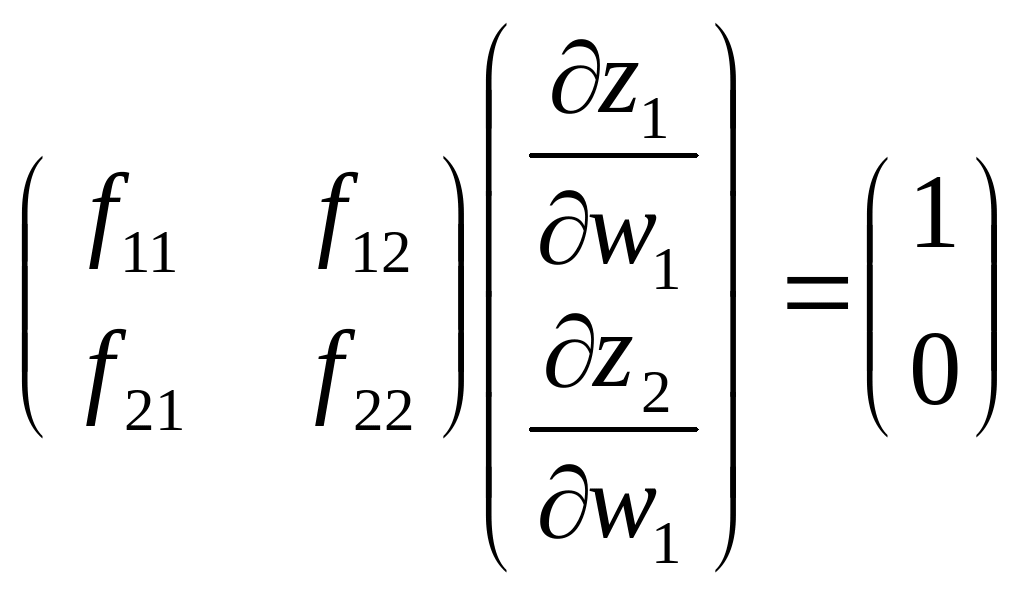
Differentiating w.r.t. w2, we have


Therefore, we get
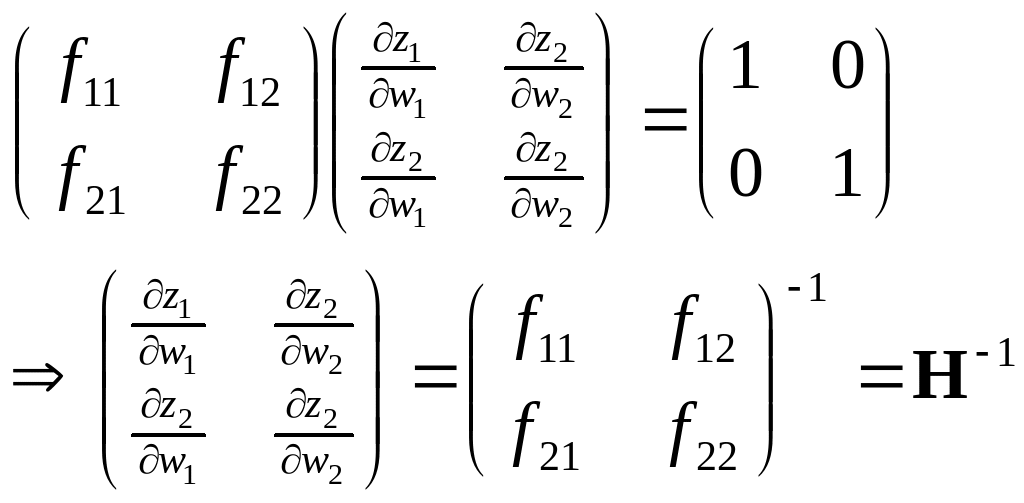
The matrix on left-hand side of the last equation is known as a substitution matrix as it specifies how the firm substitutes one input for another as the input prices change.
The second-order condition for (strict) profit maximization is the Hessian matrix H is a symmetric negative definite matrix. From Linear Algebra, we know that H-1 must also be a symmetric, negative definite matrix. This result leads to the following important properties of the input demand functions:
zi/wi < 0 for i = 1, 2, since the diagonal entries of a negative definite matrix must be negative;
zi/wj = zj/wi, by the symmetry of the matrix.
Case 3: General case - multiple inputs
We can normalize p = 1. The FOC is
f(z(w)) = w
Differentiate it w.r.t. w leads to
2f(z(w))z(w) = I Hz(w) = I
Solving this for the substitution matrix, we have
z(w) = [H(f(z))-1|z = z(w)
From this identity, we will have similar results as for the case of two inputs.
6.2.2 Comparative Statics Using the Profit Function
Implications of Properties of the Profit Function
We now get back to the key properties of the profit function:
monotonicity, homogeneous of degree 1 and convexity
Monotonicity implies that partial derivative of (p) with respect to the price of good i is negative if the good i is an input and positive if the good i is an output.
Homogenous of degree 1 implies that
Scaling all prices by a common positive factor will not change the optimal choice of the firm, i.e., the net supply functions are homogenous of degree 0.
6.2.3 The LeChatelier Principle
We are motivated to look into the short-run response of s firm's supply behavior as compared to the long-run response.
Since there is no fixed input in the long run, we would expect that the firm will respond more (net supply) to a price change in the long run than in the short run. (Trying to place the issue in the context of labor and capital.)
This is the so-called LeChatelier Principle.
Let us consider the case of single output and two inputs with a production function
q = f(z1, z2)
Assume that z2 = z20 is an fixed input. The profit function then becomes
![]()
Then the FOC is simply
p f1(z1, z20) = w1
and the (sufficient) second-order condition is p f11 < 0. The corresponding input demand function (solving z1 from the FOC) is
z1 = z1S(w1, p, z20)
(Note that w2 does not enter this demand curve). Now differentiating the following equality (by plugging z1S into the FOC):
p f1(z1S, z20) = w1
w.r.t. w1, we have
![]()
Recall that for the long-run case (both inputs are variable inputs), we have the following result (without assuming p=1):

From linear algebra, we will have the following:

Remember that the second-order conditions are: f11 < 0, f22 < 0 and f11 f22 - f122 > 0. Therefore,

Since both
![]() are negative, the above inequality says that the change in z1,
due to a change in its price is larger, in absolute value, when z2
is variable (the long-run) than z2 is fixed
(short-run).
are negative, the above inequality says that the change in z1,
due to a change in its price is larger, in absolute value, when z2
is variable (the long-run) than z2 is fixed
(short-run).
The above conclusion is sometimes referred to as the "second law of demand".
6.3 Duality in Production
In our discussion of the cost function, we are more or less relying on the specification of production. This is one part of the duality of production and cost functions. In this section, we will discuss the derivation of the production function from the cost function - the so-called duality in production.
For simplicity, we will focus on the case of two inputs. In this case, the first-order conditions are:
![]()
From these, we get the conditional input demand functions:
![]()
The corresponding cost function is denoted by c(w1, w2, q).
Note that the second-order sufficient conditions implies that zi/wi < 0, i = 1, 2. But from Shepherd's lemma, we will have
![]()
meaning that the second partials of the cost function w.r.t. input prices are negative.
6.3.1 Duality in Production
We know that the cost function is homogeneous of degree 1 in input prices. Then zi is homogeneous of degree 0 since zi is the first partial of c. Then according to Euler's Theorem, we have

![]()
Eliminating w1 and w2 (taking the second term of each eq. to the right hand side and divide each side of the first eq. by that of the second) reveals that
c11c22 - c122 = 0
saying that the determinant of the cross-partials of c with respect to input prices is 0.
Derivation of Production Function from Cost Function (Duality Result)
In fact, this is quite simple. Since the conditional input demand functions are homogenous of degree 0 in input prices, then we must have:
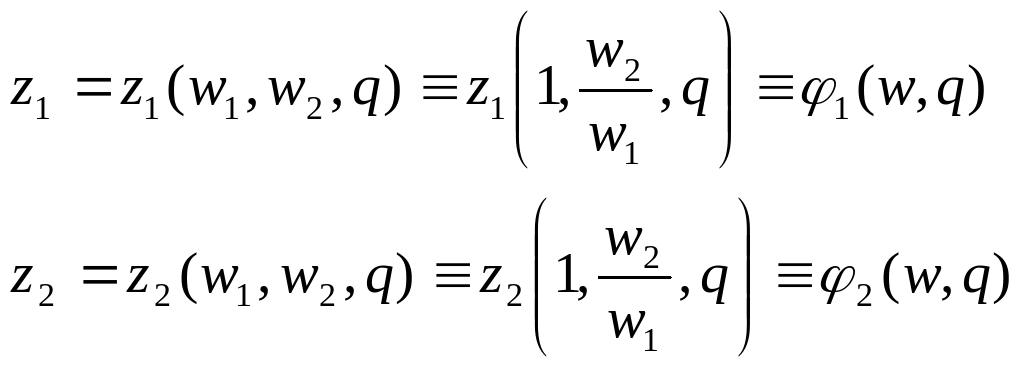
where w = w2/w1. This leads to two equations with four variables, z1, z2, w and q. By eliminating variable w and solve for q will generate the production function we need.
Example
Consider the cost function:

Then,
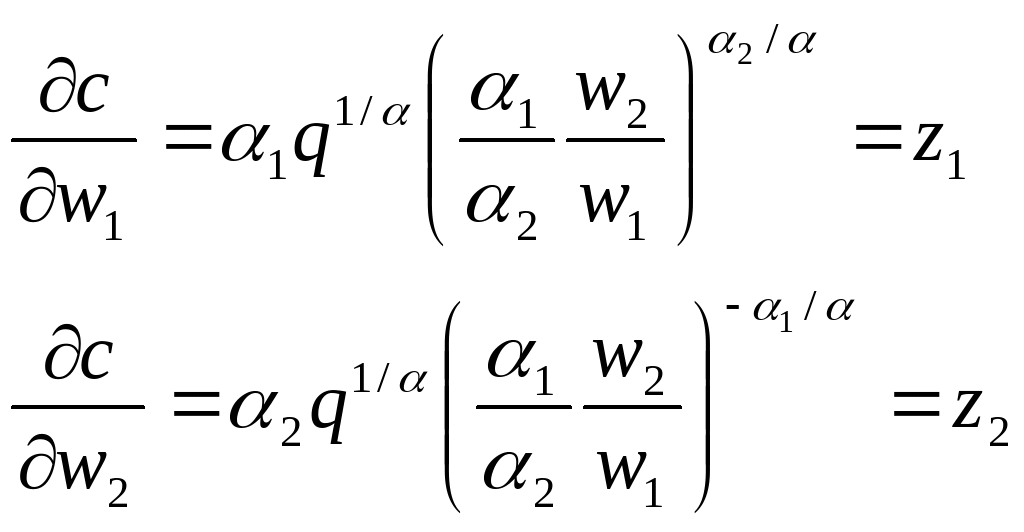
which leads to the following production function:
![]() .
.
6.3.2 The Geometry of Duality
Price
1
Isocost
w'
w
z' z
Price 2 Input
2
Isoquant
z
z w
w'
Input 1










The slope conditions are:
The slope at a point (w1*, w2*) on an isocost function is

For the isoqunat defined by q = f(z), the slope at a point z* is given by

Now, if (z1*, z2*) is a cost-minimizing point at prices (w1*, w2*), we know that it must satisfy the first-order condition:

This result is exactly the feature of duality:
the slope of the isoquant curve gives the ratio of the input prices while the slope of the isocost curve gives the ratio of input level.
6.3.3 The Importance of Duality
The duality of cost and production functions is important for reasons other than the mathematical elegance.
Economists will have occasions to estimate conditional input demand and cost functions. There are two basic ways to approach this problem.
One way is to estimate, by some procedure, the underlying production function for some activity and to then calculate, by inverting the implied first-order conditions, the conditional input demand curves (holding output constant). The cost function can be calculated also.
This, however, is a very arduous procedure. Production functions are largely unobservable. The data points will represent a sampling of input and output levels that will have taken place as different times, as input or output prices changed.
It would seem to make sense to start with estimating the cost functions or the conditional input demand curves directly; i.e., some functional form of the cost function could be asserted, say a logarithm linear function, and costs could be estimated directly.
However, this procedure would always be subject to the criticism that the estimated cost or demand functions were beasts without parents, i.e., they were derived from fictitious, or nonexistent, production processes. And this would be a serious criticism indeed.
However, the duality results rescue this simpler approach. We can be assured that if a cost function satisfies some elementary properties, i.e., homogenous of degree 1 and concavity in input prices, then there is in fact some real, unique underlying production function. Therefore, the cost function will be more plausible.
Technical Appendix for Topic 6
The Profit Function for Cobb-Douglas Technology
First, the first order conditions are:
![]()
which immediately lead to
![]()
Substituting z2 into the second first-order condition, we get
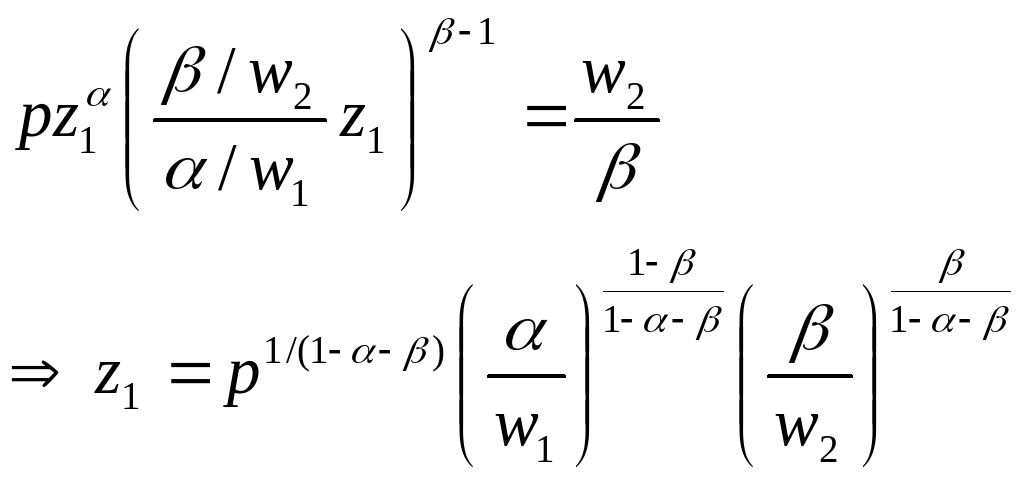
So,

Now,

Therefore the profit function is given by:

as required.
Additional References:
Hicks, J. (1946) Value and Capital. Clarendon Press, Oxford, England.
Hotelling, H. (1932) “Edgeworth’s taxation paradox and the nature of demand and supply function,” Journal of Political Economy, 40, 577-616.
Samuelson, P. (1947) Foundations of Economic Analysis. Harvard University Press, Cambridge, Massachusetts.
Silberberg, E. (1990) The Structure of Economics - A Mathematical Analysis. Second Edition. McGraw-Hill, New York. (Chapters 4, 7, 8 & 9)
Varian, H. R. (1992) Microeconomic Analysis. Third Edition. W.W. Norton & Company, New York. (Chapters 2, 3, & 6)
1984 ADVANCED PLACEMENT EXAM PART I MULTIPLE CHOICE NOTE
1ADVANCED TORTS OUTLINE I PUNITIVE DAMAGES A PURPOSE OF
20047 HSC ENGLISH STANDARD AND ADVANCED COURSES
Tags: advanced microeconomics, topic, microeconomics, advanced, theory
- KATI HORNA LA HEROÍNA OCULTA TRAS LA GRAN
- UNDERSTANDING HYPOGLYCEMIA (LOW BLOOD SUGAR) HYPOGLYCEMIA ALSO CALLED “LOW
- CIRCULAR A LAS FAMILIAS ESTIMADAS FAMILIAS DEL ALUMNADO DE
- APPLICATION FORM FOR APPROVAL AS A SPONSOR A APPLICANT
- (TEKST JEDNOLITY) ZARZĄDZENIE NR 362016 REKTORA UNIWERSYTETU KARDYNAŁA STEFANA
- CAPITULO I AGUA P‡GINA 49 PADILLA AF
- NIZAMI GASİLOV BME II MAT 281 DOĞRUSAL CEBIR VE
- NA TEMELJU ČLANKA 30 STAVAK 4 I 5 ZAKONA
- 300 000 JAHRE ALTES GESCHIEBE DER SAALEEISZEIT BEI HÖLTINGHAUSEN
- PEPIN COUNTY HEALTH DEPARTMENT 2015 ANNUAL REPORT MISSION…TO PROTECT
- MODELO DE PROGRAMAS A PRESENTAR FUNDAMENTACION DE LA
- 6º PLANNING DE SEXTO DEL ÁREA DE LENGUA –
- Anexo%20I_solicitud%20ocupacion
- CONFERENZA MATEMATICA E LINGUISTICA RECENZIONE MARIA CRISTINA
- PROGRAM KREATIVITAS MAHASISWA PELATIHAN MATERI GIZI SEIMBANG PADA PENGAJAR
- ROBERT E MCDONALD UNITED SUPERMARKETS PROFESSOR OF MARKETING AREA
- PATHOPHYSIOLOGY OF BLOOD BLOOD SYSTEM INCLUDES THREE COMPONENTS THE
- MINISTERIO DE CIENCIA TÉCNICA E INNOVACIÓN PRODUCTIVA COMISIÓN DE
- ANEXO III SOLICITUD DE ADMISIÓN A LAS PRUEBAS SELECTIVAS
- PELUANG 1 ATURAN PERKALIAN JIKA SUATU PERISTIWA DAPAT TERJADI
- A PACEF MENÚS CUINA CENTRALITZADA – OCTUBRE 2016
- T HE BREADWINNER A BOOK STUDY READ THE
- MODELS OF MARKET SOCIALISM SOCIALIST GOALS 1) EQUALITY OF
- POLIEDROSCONTROL C EJERCICIO Nº 1 ESCRIBE EL NOMBRE DE
- KOMUNALAC DOO 43000 BJELOVAR FERDE LIVADIĆA 14 A OIB
- 7 BYLAW NO 202001 BYLAW NO 202001 BEING A
- INFORMACIÓN PROGRAMA “ABIERTO POR VACACIONES” SEMANA SANTA 2019 ALUMNADO
- CONSULTANTS TO THE PROJECT PROFESSOR TAIEB BELGHAZI TAIEB BELGHAZI
- !doctype Htmlhtml Langen!![endif] head meta Charsetutf8 meta Contentieedge
- 4 ANCIENT HISTORY UNIT 4 CONTRIBUTION TO THE DEVELOPMENT
MODELOS DE PODERES PARA FINS DE ORIENTAÇÃO LISTAMSE A
 TRIGONOMETRÍA A) RELACIONES TRIGONOMÉTRICAS EN UN TRIÁNGULO RECTÁNGULO POR
TRIGONOMETRÍA A) RELACIONES TRIGONOMÉTRICAS EN UN TRIÁNGULO RECTÁNGULO POR 5 AYUNTAMIENTO DE TORRELODONES ( MADRID) (CP 28250) ……
5 AYUNTAMIENTO DE TORRELODONES ( MADRID) (CP 28250) ……DJEČJI VRTIĆ ŠIBENSKA MASLINA ULICA BRANITELJA DOMOVINSKOG RATA 2G
LA VOCACIÓN DE ABRAHAM LOS HOMBRES VOLVIERON A OLVIDARSE
 CARTA COMPROMISO FERIA INTERZUM CHINA 2017 GUANGZHOU CHINA 28
CARTA COMPROMISO FERIA INTERZUM CHINA 2017 GUANGZHOU CHINA 28OZNÁMENÍ O VYHLÁŠENÍ VÝBĚROVÉHO ŘÍZENÍ NA SLUŽEBNÍ MÍSTO STÁTNÍHO
GUÍA PARA EL USUARIO DE STAR GUÍA PARA EL
1512003 (IX 22) KORM RENDELET AZ EGYES TARTÓS FOGYASZTÁSI
1AN ALPHABETISED LIST OF VOCABULARY REFERENCES ALL OF THE
YVETTE GOSS EDUCATION AND TRAINING WORKFORCE SCHOOLS PRODUCTIVITY COMMISSION
SITE ASSESSMENT SCORE SHEET AGRICULTURAL VALUES CRITERIA PRIORITY
OBRAZAC POTVRDE (IZJAVE) (SPORTSKI KLUB U ZAGREBU)
PERATURAN MENTERI KOMUNIKASI DAN INFORMATIKA NOMOR PERMKOMINFO2006
 ФИЛМСКЕ НОВОСТИ БУЛ ВОЈВОДЕ МИШИЋА 39А 11000 БЕОГРАД
ФИЛМСКЕ НОВОСТИ БУЛ ВОЈВОДЕ МИШИЋА 39А 11000 БЕОГРАД UMOWA O ŚWIADCZENIE USŁUGI OCHRONY FIZYCZNEJ OBIEKTU ZAWARTA W
GUÍA PARA EL DILIGENCIAMIENTO DEL FORMULARIO DE HOGARES POSTULADOS
…………………MÜDÜRLÜĞÜ SIĞINAK TALİMATI AMAÇ MADDE 1 ………………………… PERSONELINI
 LA CIENCIA EN EL COMBATE AL COMERCIO ILEGAL DE
LA CIENCIA EN EL COMBATE AL COMERCIO ILEGAL DEKOMPLEKSNOST ALGORITAMA (X) PROF DR DRAGAN JANKOVIĆ PREGLED TEHNIKA